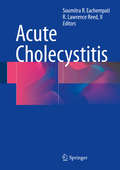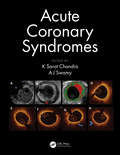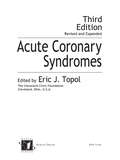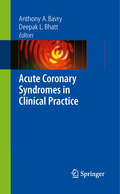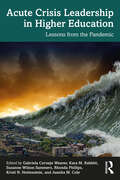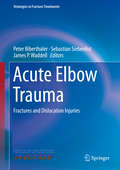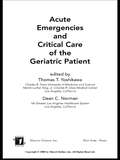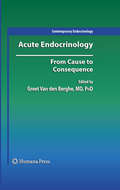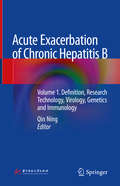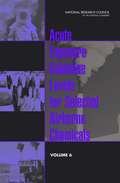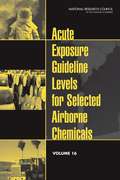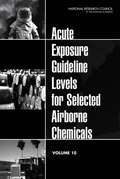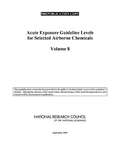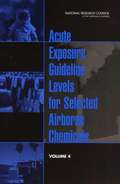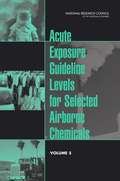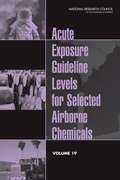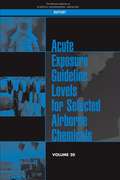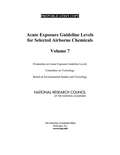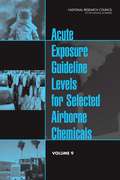- Table View
- List View
Acute Cholecystitis
by Soumitra R. Eachempati R. Lawrence ReedThis text covers all aspects of the current diagnosis and treatment of acute cholecystitis. Different diagnostic tests are discussed as well as the preoperative evaluation needed to initiate treatment. Other sections include the management of acute cholecystitis in the critically ill and elderly patients, recent advances in operative strategies that have further altered the treatment of acute cholecystitis, and the utilization of routine intraoperative cholangiography and its relative merits. Primarily intended for general surgeons and residents training in general surgery, Acute Cholecystitis will also serve as a comprehensive reference material for other health care providers, including primary care providers, mid-level nurse practitioners, emergency room physicians and medical students.
Acute Coronary Syndromes
by K Sarat Chandra Aj SwamyAcute Coronary Syndrome (ACS) is a growing global menace with patients increasing in developing countries where tobacco and food play a major role. Its treatment guidelines and research results have proliferated in academia, but practical applications lag behind that research. This book addresses this void. Guidelines for treatment of ACS present in-depth reading for practicing cardiologists, thus preventing clinical application. The book aims to appraise readers of real-world situations and suggestions to help them acquire up-to-date knowledge on ACS and its effective diagnosis, prognosis and management. Key Features Covers recent advances in ACS management and pharmacotherapy Discusses the guidelines for treatment of ACS for the professional cardiologist to apply to clinical practice Explores the topics with the help of case scenarios Follows a concise, yet comprehensive approach Features a chapter on 'When to Transfer,' which discusses how to spot unstable patients or those heading towards shock
Acute Coronary Syndromes (Contemporary Cardiology Ser.)
by Eric J. TopolWith detailed contributions from 45 renowned international authorities, this Third Edition stands alone as the most comprehensive, contemporary view of the biology, physiology, and management of acute coronary syndromes (ACS)-offering 32 chapters that span the state-of-the science in the field and provide intriguing discussions on CRP and other dis
Acute Coronary Syndromes in Clinical Practice
by Deepak L. Bhatt Anthony A BavryThis practical book provides a comprehensive overview of the epidemiology and clinical presentation of acute coronary syndromes (ACS). It also guides the reader through risk assessment, risk stratification, diagnosis, and treatment of ACS.
Acute Crisis Leadership in Higher Education: Lessons from the Pandemic
by Rhonda Phillips Gabriela Cornejo Weaver Kara M. Rabbitt Suzanne Wilson Summers Kristi N. Hottenstein Juanita M. ColeThis book explores higher education leadership during times of extreme pressures and limited, changing information. Organized around different functional units in higher education institutions, chapters describe the ways in which campus communities were affected by and responded to the early pandemic crisis. By unpacking observations of real leaders from American institutions of higher education during the COVID-19 pandemic, this book provides lessons learned and takeaway strategies for complex decision-making during a crisis. This edited collection explores the unique moment when leaders and teams must make, implement, and adjust plans rapidly to assure delivery of their missions, while still addressing the needs of students, parents, employees, and stakeholders. Shining a bright light on decision-making in the early acute stage of a crisis, this book prepares higher education educators to be effective leaders and successful decision-makers.
Acute Elbow Trauma: Fractures And Dislocation Injuries (Strategies in Fracture Treatments)
by Peter Biberthaler James P. Waddell Sebastian SiebenlistThis volume focuses on acute trauma to the adult elbow, including fractures, dislocations, tendon ruptures, and vascular and nerve injuries. Each chapter addresses anatomical key features, surgical and conservative therapeutic procedures, postoperative regimes and complication strategies. International elbow experts explore a range of surgical approaches, the usage of modern implants, advances in surgical techniques, and pearls and pitfalls for each trauma entity. Moreover, the authors describe total elbow arthroplasty and radial head replacement in detail, outline current clinical outcomes, and provide recommendations for therapeutic approaches and salvage measures. The book enables the orthopedic surgeon to deal with the entire spectrum of acute simple and complex elbow injuries in adults.
Acute Emergencies and Critical Care of the Geriatric Patient
by Thomas T. Yoshikawa Dean C. NormanThis incisive reference systematically reviews the diagnosis and treatment of common surgical and medical emergencies in elderly patients-thoroughly examining surgical interventions, drug therapies and drug prescribing protocols, life-threatening drug reactions, ethical issues, and methods of profiling patients for nursing care. Evaluates disea
Acute Endocrinology: From Cause to Consequence (Contemporary Endocrinology)
by Greet Van den BergheThe integration of endocrinology in critical care medicine has led to new experimental and clinical data on the complex endocrine and metabolic derangements accompanying non-endocrine severe illnesses. The joining of these two disciplines has generated important novel insights with significant clinical implications. Acute Endocrinology: From Cause to Consequence compiles these new findings into an important and highly relevant new resource. Part one deals with the classical life-threatening illnesses caused by primary endocrine diseases such as thyrotoxicosis, hypothyroidism, acute adrenal crisis, acute calcium disorders, pheochromocytoma, severe hyper- and hypoglycemia. Part two looks at endocrinology from the ICU side, starting with a general overview of the dynamic neuroendocrine and metabolic stress responses in the condition of intensive care-dependent, non-endocrine critical illness. Acute Endocrinology: From Cause to Consequence provides a unique and up-to-date overview of the joining of these two disciplines and seeks to stimulate further interdisciplinary research in this important and exciting field.
Acute Exacerbation of Chronic Hepatitis B: Volume 1. Definition, Research Technology, Virology, Genetics and Immunology
by Qin NingThis book assembles recent achievements in both basic research and clinical management in the field of hepatology, virology and immunology. It provides up-to-date information for clinicians who can apply the relevant knowledge to their daily clinical practice and for researchers who are interested in clinically orientated studies. The updated and detailed technology, state-of–the-art treatment strategies provided in this book serve as references for clinicians and resident physicians in the daily management of ACLF. The rationality and strategies for basic research as well as patient management in this book can also be a valuable reference for other fatal and end stage liver diseases than HBV induced ACLF. This volume 1 has 6 chapters and focuses on the definition, research technology, virology, genetics, and immunology.
Acute Exacerbation of Chronic Hepatitis B: Volume 2. Diagnosis and Management
by Qin NingThis book assembles recent achievements in both basic research and clinical management in the field of hepatology, virology and immunology. It provides up-to-date information for clinicians who can apply the relevant knowledge to their daily clinical practice and for researchers who are interested in clinically orientated studies. The updated and detailed technology, state-of–the-art treatment strategies provided in this book serve as references for clinicians and resident physicians in the daily management of ACLF. The rationality and strategies for basic research as well as patient management in this book can also be a valuable reference for other fatal and end stage liver diseases than HBV induced ACLF. This Volume 2 has 6 chapters and focuses on its diagnosis and management.
Acute Exposure Guideline Levels for Selected Airborne Chemicals: VOLUME 6
by National Research Council of the National AcademiesThis book is the sixth volume in the series Acute Exposure Guideline Levels for Selected Airborne Chemicals, and includes AEGLs for chemicals such as ammonia, nickel carbonyl and phosphine, among others.<P><P> At the request of the Department of Defense, the National Research Council has reviewed the relevant scientific literature compiled by an expert panel and established Acute Exposure Guideline Levels (AEGLs) for 12 new chemicals. AEGLs represent exposure levels below which adverse health effects are not likely to occur and are useful in responding to emergencies such as accidental or intentional chemical releases in the community, the workplace, transportation, the military, and for the remediation of contaminated sites. Three AEGLs are approved for each chemical, representing exposure levels that result in: 1) notable but reversible discomfort; 2) long-lasting health effects; and 3) life-threatening health impacts.
Acute Exposure Guideline Levels for Selected Airborne Chemicals
by National Research Council Committee on Toxicology Division On Earth Life Studies Committee on Acute Exposure Guideline Levels Board on Environmental Studies ToxicologyAcute Exposure Guideline Levels for Selected Airborne Chemicals, Volume 15 identifies, reviews, and interprets relevant toxicologic and other scientific data for ethyl mercaptan, methyl mercaptan, phenyl mercaptan, tert-octyl mercaptan, lewisite, methyl isothiocyanate, and selected monoisocyanates in order to develop acute exposure guideline levels (AEGLs) for these high-priority, acutely toxic chemicals. AEGLs represent threshold exposure limits (exposure levels below which adverse health effects are not likely to occur) for the general public and are applicable to emergency exposures ranging from 10 minutes (min) to 8 h. Three level--AEGL-1, AEGL-2, and AEGL-3--are developed for each of five exposure periods (10 min, 30 min, 1 h, 4 h, and 8 h) and are distinguished by varying degrees of severity of toxic effects. This report will inform planning, response, and prevention in the community, the workplace, transportation, the military, and the remediation of Superfund sites.
Acute Exposure Guideline Levels for Selected Airborne Chemicals
by Committee on Acute Exposure Guideline LevelsThe Bhopal Disaster of 1984 resulted in the death of around 2,000 residents living near chemical plants and irreversible injuries to more than 20,000 other residents. These numbers can be attributed to the community's lack of awareness concerning the chemicals' existence, dangers and effects, and/or how to react in case of emergency. The disaster emphasized the need for governments to identify hazardous substances and to aid local communities in developing plans for emergency exposures. As a result, the United States government issued the Superfund Amendments and Reauthorization Act (SARA) of 1986; requiring the identification of extremely hazardous substances (EHSs) by the Environmental Protection Agency (EPA). EPA was also tasked with assisting Local Emergency Planning Committees (LEPCs) in conducting health-hazard assessments to develop emergency-response plans for sites where EHSs are produced, stored, transported, or used. The EPA identified nearly 400 EHSs in terms of their immediate danger to life and health (IDLH) as their first step in assisting these LEPCs. In 1991 the EPA went on to request that the National Research Council (NRC) Committee on Toxicology (COT) develop criteria and methods for developing emergency exposure levels for EHSs for the general population. The COT, who had published many reports on emergency exposure guidance levels at the time, designated the task to a subcommittee. The subcommittee focused on Guidelines for Developing Community Emergency Exposure Levels for Hazardous Substances. Four years later the National Advisory Committee for Acute Exposure Guideline Levels for Hazardous Substances (NAC) was created with a focus on identifying, reviewing, and interpreting relevant toxicologic and other scientific data and developing acute exposure guideline levels (AEGLs) for high-priority, acutely toxic chemicals. In Acute Exposure Guideline Levels for Selected Airborne Chemicals: Volume 4, the NAC outlines acute exposure guideline levels for chlorine, hydrogen chloride, toluene 2,4, hydrogen fluoride, 2,6-diisocyanate, and uranium hexafluoride.
Acute Exposure Guideline Levels for Selected Airborne Chemicals
by The National Academy of SciencesExtremely hazardous substances (EHSs)sup2; can be released accidentally as a result of chemical spills, industrial explosions, fires, or accidents involving railroad cars and trucks transporting EHSs. Workers and residents in communities surrounding industrial facilities where EHSs are manufactured, used, or stored and in communities along the nation's railways and highways are potentially at risk of being exposed to airborne EHSs during accidental releases or intentional releases by terrorists. Pursuant to the Superfund Amendments and Reauthorization Act of 1986, the U. S. Environmental Protection Agency (EPA) has identified approximately 400 EHSs on the basis of acute lethality data in rodents. As part of its efforts to develop acute exposure guideline levels for EHSs, EPA and the Agency for Toxic Substances and Disease Registry (ATSDR) in 1991 requested that the National Research Council (NRC) develop guidelines for establishing such levels. In response to that request, the NRC published Guidelines for Developing Community Emergency Exposure Levels for Hazardous Substancesin 1993. Subsequently, Standard Operating Procedures for Developing Acute Exposure Guideline Levels for Hazardous Substanceswas published in 2001, providing updated procedures, methodologies, and other guidelines used by the National Advisory Committee (NAC) on Acute Exposure Guideline Levels for Hazardous Substances and the Committee on Acute Exposure Guideline Levels (AEGLs) in developing the AEGL values. In 1998, EPA and DOD requested that the NRC independently review the AEGLs developed by NAC. In response to that request, the NRC organized within its Committee on Toxicology (COT) the Committee on Acute Exposure Guideline Levels, which prepared this report. Acute Exposure Guideline Levels for Selected Airborne Chemicalsis the tenth volume of the series and documents for N,N-dimethylformamide, jet propellant fuels 5 and 8, methyl ethyl ketone, perchloromethyl mercaptan, phosphorus oxychloride, phosphorus trichloride, and sulfuryl chloride.
Acute Exposure Guideline Levels for Selected Airborne Chemicals: VOLUME 1
by National Research CouncilIn the Bhopal disaster of 1984, approximately 2,000 residents living near a chemical plant were killed and 20,000 more suffered irreversible damage to their eyes and lungs following the accidental release of methyl isocyanate. This tragedy served to focus international attention on the need for governments to identify hazardous substances and assist local communities in planning how to deal with emergency exposures. Since 1986, the U.S. Environmental Protection Agency has been tasked with identifying extremely hazardous substances and, in cooperation with the Federal Emergency Management Agency and the Department of Transportation, assist local emergency response planners. The National Advisory Committee on Acute Exposure Guideline Levels for Hazardous Substances was established in 1995 to develop acute exposure guideline levels (AEGLs) for high priority toxic chemicals that could be released into the air from accidents at chemical plants, storage sites, or during transportation. This book reviews toxicity documents on five chemicals--chlorine, hydrogen chloride, hydrogen fluoride, toluene, and uranium hexafluoride--for their scientific validity, comprehensives, internal consistency, and conformance to the 1993 guidelines report.
Acute Exposure Guideline Levels for Selected Airborne Chemicals: VOLUME 2
by National Research Council of the National AcademiesThis book reviews toxicity documents on five chemicals that can be released in the air from accidents at chemical plants, storage sites, or during transportation. The documents were prepared by the National Advisory Committee on Acute Exposure Guideline Levels for Hazardous Substances and were evaluated for their scientific validity, comprehensives, internal consistency, and conformance to the 1993 guidelines report.
Acute Exposure Guideline Levels for Selected Airborne Chemicals: VOLUME 3
by National Research Council of the National AcademiesThis report is the third volume in the series Acute Exposure Guideline Levels for Selected Airborne Chemicals. <P><P> In the Bhopal disaster of 1984, approximately 2,000 residents living near a chemical plant were killed and 20,000 more suffered irreversible damage to their eyes and lungs following accidental release of Methyl Isocyanate. The toll was particularly high because the community had little idea what chemicals were being used at the plant, how dangerous they might be, and what steps to take in case of emergency. This tragedy served to focus international attention on the need for governments to identify hazardous substances and to assist local communities in planning how to deal with emergency exposures.
Acute Exposure Guideline Levels for Selected Airborne Chemicals: VOLUME 4
by National Research Council of the National AcademiesThis book is the eighth volume in the series Acute Exposure Guideline Levels for Selected Airborne Chemicals, and reviews AEGLs for acrolein, carbon monoxide, 1,2-dichloroethene, ethylenimine, fluorine, hydrazine, peracetic acid, propylenimine, and sulfur dioxide for scientific accuracy, completeness, and consistency with the NRC guideline reports.
Acute Exposure Guideline Levels for Selected Airborne Chemicals: VOLUME 4
by Subcommittee on Acute Exposure Guideline LevelsInformation on Acute Exposure Guideline Levels for Selected Airborne Chemicals.
Acute Exposure Guideline Levels for Selected Airborne Chemicals: VOLUME 5
by National Research Council of the National AcademiesIn 1993, the National Research Council';s Committee on Toxicology developed criteria and methods for EPA and the Agency for Toxic Substances and Disease Registry (ATSDR) to develop community emergency exposure levels for extremely hazardous substances for the general population. <P><P>A few years later, the National Advisory Committee for Acute Exposure Guideline Levels for Hazardous Substances (NAC)--composed of members of EPA, DOD, other federal and state agencies, industry, academia, and other organizations--was established to identify, review, and interpret toxicologic and other scientific data to develop acute exposure guidelines (AEGLs) for high-priority, acutely toxic chemicals. Three levels--AEGL-1, AEGL-2, and AEGL-3 are developed for each of five exposure periods (10 min, 30 min, 1 hr, 4 hr, and 8 hr) and are distinguished by varying degrees of severity of toxic effects. This current report reviews the NAC reports for their scientific validity, completeness, and consistency with the NRC guideline reports developed in 1993 and 2001. This report is the fifth volume in the series and covers AEGLs for chlorine dioxide, chlorine trifluoride, cyclohexylamine, ethylenediamine, hydrofluoroether-7100, and tetranitromethane. It concludes that the AEGLs developed by NAC are scientifically valid and consistent with the NRC guideline reports. AEGLs are needed for a wide range of planning, response, and prevention applications. These values provide data critical to evacuation decisions and discussions between community leaders and industries as they seek ways to minimize the health impact should the chemical release occur. Some of the finalized AEGLs have been officially adopted by the Department of the Army, FEMA, and the Department of Transportation as the official levels for use by those agencies.
Acute Exposure Guideline Levels for Selected Airborne Chemicals: Volume 17
by Committee on Acute Exposure Guideline LevelsExtremely hazardous substances can be released accidentally as a result of chemical spills, industrial explosions, fires, or accidents involving railroad cars and trucks transporting EHSs. Workers and residents in communities surrounding industrial facilities where these substances are manufactured, used, or stored and in communities along the nation's railways and highways are potentially at risk of being exposed to airborne EHSs during accidental releases or intentional releases by terrorists. Pursuant to the Superfund Amendments and Reauthorization Act of 1986, the U. S. Environmental Protection Agency (EPA) has identified approximately 400 EHSs on the basis of acute lethality data in rodents. "Acute Exposure Guideline Levels for Selected Airborne Chemicals, Volume 17" identifies, reviews, and interprets relevant toxicologic and other scientific data for selected AEGL documents for acrylonitrile, carbon tetrachloride, cyanogen, epichlorohydrin, ethylene chlorohydrin, toluene, trimethylacetyl chloride, hydrogen bromide, and boron tribromide in order to develop acute exposure guideline levels (AEGLs) for these high-priority, acutely toxic chemicals. AEGLs represent threshold exposure limits (exposure levels below which adverse health effects are not likely to occur) for the general public and are applicable to emergency exposures ranging from 10 minutes (min) to 8 h. Three levels - AEGL-1, AEGL-2, and AEGL-3 - are developed for each of five exposure periods (10 min, 30 min, 1 h, 4 h, and 8 h) and are distinguished by varying degrees of severity of toxic effects. This report will inform planning, response, and prevention in the community, the workplace, transportation, the military, and the remediation of Superfund sites.
Acute Exposure Guideline Levels for Selected Airborne Chemicals: Volume 20
by Engineering Medicine National Academies of SciencesExtremely hazardous substances can be released accidentally as a result of chemical spills, industrial explosions, fires, or accidents involving railroad cars and trucks transporting EHSs. Workers and residents in communities surrounding industrial facilities where these substances are manufactured, used, or stored and in communities along the nation’s railways and highways are potentially at risk of being exposed to airborne EHSs during accidental releases or intentional releases by terrorists. Pursuant to the Superfund Amendments and Reauthorization Act of 1986, the U.S. Environmental Protection Agency (EPA) has identified approximately 400 EHSs on the basis of acute lethality data in rodents. Acute Exposure Guideline Levels for Selected Airborne Chemicals, Volume 20 reviews and updates the technical support document on acute exposure guideline levels (AEGLs) for selected chloroformates. This update focuses on establishing AEGL-3 values for n-propyl chloroformate and isopropyl chloroformate, but will also consider whether any new data are available that would affect the proposed values for the other 10 chloroformates. AEGLs represent threshold exposure limits (exposure levels below which adverse health effects are not likely to occur) for the general public and are applicable to emergency exposures ranging from 10 minutes (min) to 8 h. Three levels - AEGL-1, AEGL-2, and AEGL-3 - are developed for each of five exposure periods (10 min, 30 min, 1 h, 4 h, and 8 h) and are distinguished by varying degrees of severity of toxic effects. This report will inform planning, response, and prevention in the community, the workplace, transportation, the military, and the remediation of Superfund sites.
Acute Exposure Guideline Levels for Selected Airborne Chemicals: Volume 7
by National Research Council of the National AcademiesThis book is the seventh volume in the series Acute Exposure Guideline Levels for Selected Airborne Chemicals, and includes AEGLs for acetone cyanohydrin, carbon disulfide, monochloroacetic acid, and phenol. <P><P>At the request of the Department of Defense, the National Research Council has reviewed the relevant scientific literature compiled by an expert panel and established Acute Exposure Guideline Levels (AEGLs) for 12 new chemicals. AEGLs represent exposure levels below which adverse health effects are not likely to occur and are useful in responding to emergencies such as accidental or intentional chemical releases in the community, the workplace, transportation, the military, and for the remediation of contaminated sites. Three AEGLs are approved for each chemical, representing exposure levels that result in: 1) notable but reversible discomfort; 2) long-lasting health effects; and 3) life-threatening health impacts.
Acute Exposure Guideline Levels for Selected Airborne Chemicals: Volume 8
by National Research Council of the National AcademiesThis book is the eighth volume in the series Acute Exposure Guideline Levels for Selected Airborne Chemicals, and reviews AEGLs for acrolein, carbon monoxide, 1,2-dichloroethene, ethylenimine, fluorine, hydrazine, peracetic acid, propylenimine, and sulfur dioxide for scientific accuracy, completeness, and consistency with the NRC guideline reports.
Acute Exposure Guideline Levels for Selected Airborne Chemicals: Volume 9
by National Research Council of the National AcademiesThis book is the ninth volume in the series Acute Exposure Guideline Levels for Selected Airborne Chemicals, and reviews AEGLs for bromine, ethylene oxide, furan, hydrogen sulfide, propylene oxide, and xylenes.
